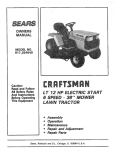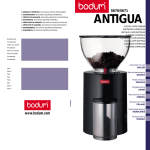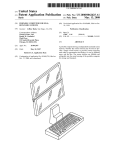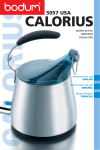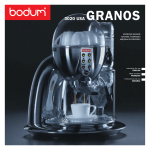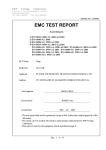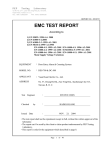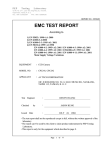Download Interactive educational toy
Transcript
US006463257B1 (12) United States Patent (10) Patent N0.: (45) Date of Patent: Wood (54) INTERACTIVE EDUCATIONAL TOY (75) Inventor: Michael C. Wood, Orinda, CA (US) (73) Assignee: Knowledge Kids Enterprises, Inc., Emeryville, CA (US) VTech 1995. VTech VTech VTech US 6,463,257 B1 *Oct. 8,2002 Smart Play, “Little Smart Number Desk”, 4 pages, Little Smart Dial A Smile Manual, 6 pages, 1993. Fun to Talk Phone Manual, 5 pages, 1993. “Little Smart Number Desk” Manual, 6 pages (no date printed). (*) Notice: Subject to any disclaimer, the term of this patent is extended or adjusted under 35 U.S.C. 154(b) by 0 days. LeapFrog “Create—a—Word SuperMat” and “Create—a—Word Traveler” Manual, 2 pages, 1997. “Classic Toys 2001: VTech Industries, Little Smart Tiny This patent is subject to a terminal dis claimer. Touch Phone”, <http://www.drtoy.org/drtoy/ vtechitinytouchi2001c.htm> , 1990* * cited by examiner (21) Appl. No.: 09/384,657 (22) Filed: Aug. 27, 1999 Primary Examiner—Klein T. Nguyen Assistant Examiner—Kurt Fernstrom Related US. Application Data (74) Attorney, Agent, or Firm—Townsend, Townsend & Crew LLP (63) Continuation-in-part of application No. 09/095,492, ?led on Jun. 10, 1998, now Pat. No. 5,944,533. (57) (51) (52) Int. Cl.7 ........................... .. G09B 5/00; A63H 3/28 us. Cl. ..................... .. 434/308; 434/335; 446/297; The present invention comprises a teaching toy that invites a child’s interaction using an attractive play ?gure, for (58) Field of Search ............................... .. 434/308, 322, 446/318 434/335, 169, 327, 393, 446/143, 268, 297, 302, 369, 368, 397 (56) References Cited * 8/1976 Favilli et al. 5,114,376 A * 5/1992 Copley et al. ............ .. 446/369 * * 6/1999 Leff et al. ................. .. 434/322 8/1999 Wood ...... .. 434/322 2/1993 Wood 6,010,339 A * 6,021,306 A * 1/2000 McDonald 2/2000 McTaggart 434/258 434/317 6,029,042 A 6,074,212 A 2/2000 Yaron-Moallim . 6/2000 Cogliano ........ .. 434/309 434/159 * * 6,179,682 B1 * 1/2001 tional modality in mixed formats. The child is presented with a declarative instruction, songs, and moving lights and kinesthetic and reasoning connections are induced in the child’s mind via games, songs, and visual stimuli. Particularly, the present invention teaches and reinforces a rhythm by use of visual, audial, and kinesthetic involvement 3,977,292 A 5,188,533 A example a stuffed animal, to present more than one instruc child’s knowledge of geometric shapes, colors, melody and U.S. PATENT DOCUMENTS 5,910,009 A 5,944,533 A ABSTRACT Plain ........................ .. 446/141 OTHER PUBLICATIONS VTech Smart Play, “Little Smart Alphabet Desk”, 3 pages, of the child. If the inventive is presented in the form of a stuffed animal, the exterior of the animal would have a plurality of indicia that the child could press. The indicia is electrically coupled to switching circuitry and those switches activate a logic circuit containing preprogrammed instruction modalities and play methods. The instruction modalities are communicated using a variety of prepro grammed fun speech patterns so that the toy appears to talk to the child and provide instruction. Each inventive toy presents least two distinct instruction modalities, for example, i) identifying a symbol by its shape and ii) asso ciating a visual stimulus with a kinesthetic action. 1992. VTech Smart Play, “Video Painter”, 3 pages, 1993. 44 Claims, 2 Drawing Sheets U.S. Patent 0a. 8,2002 Sheet 1 0f 2 US 6,463,257 B1 U.S. Patent 0a. 8,2002 Sheet 2 0f 2 PME I Em a.“ BOZSF US 6,463,257 B1 Home US 6,463,257 B1 1 2 INTERACTIVE EDUCATIONAL TOY other toys, the format is invariable Only one instruction modality is presented. Additionally there are a very feW number of phrases and tunes used. This is a continuation-in-part of US. application Ser. No. 09/095,492, ?led on Jun. 10, 1998, now US. Pat. No. SUMMARY OF THE INVENTION 5,944,533, and incorporated herein by reference. Ideally, a teaching toy Would provide an inviting format for interaction and Would combine instruction With quiZZing and logic to engage all portions of a child’s interactive capability. For a toddler, a teaching toy Would ideally combine instruction With kinesthetic and hand-eye coordi BACKGROUND OF THE INVENTION 1. Field of the Invention This invention relates generally to early stage learning skills and more speci?cally to learning colors, geometric shapes, and hand-eye coordination skills. 2. Description of Related Art Repetition is an important teaching tool. To teach a child or toddler effectively, repetition must be made interesting and fun. There are a large number of educational toys that attempt to engage a child’s interest and to teach the child any 10 logically connected and engaged: audio, visual, and kines thetic. Instruction is best reinforced When both recognition 15 very desirable to have a toy that Was attractive to a child 20 and use it exclusively. For example, in US. Pat. No. 5,376,038, issued to Avi Arad, a doll is disclosed that has electronic sWitches located in the hands, feet, nose, lips, and other body parts of the doll. When a child presses the sWitch in, for example the hand, the 25 and induction of audial and visual connections in the child’s 30 phrase in response to activation of a sWitch in a particular object, such as “dog”, “A”, or the name of a number. Again in this device the format is constant. The child sets an object that is provided as part of the toy doWn on a sensing board, 35 of the child by use of mixed instruction modalities. It is a further object of the invention to teach these concepts to toddlers of the age betWeen about 5 months and about 48 months, or more preferably betWeen about 9 months and about 24 months. Older children may also learn from or enjoy the inventive toy. 40 The present invention is an interactive learning device comprising, a) a ?gure attractive to children, the ?gure having an exterior surface; b) a plurality of indicia on the exterior surface of the ?gure; c) a light associated With the 45 indicia; d) sWitching circuitry electrically connected to the indicia; and e) a logic circuit having at least one memory and having its input terminals connected to the sWitching cir cuitry and its output terminals connected through other the object represents. While the toy is interactive, it is presented as a tablet style learning tool, a device to be used in desk fashion instead of as a play object, and only a single circuit elements to a sound synthesiZer and speaker; Wherein 50 Atoy that is available on the market, titled “What Am I”, the logic circuitry controls interaction betWeen the sWitching circuitry and a plurality of preprogrammed instruction modalities including at least tWo distinct instruction modali ties. a Golden BookTM product (Western Publishing Co. Inc.; 1220 Mound Ave.; Racine, Wis. 53404) presents a slightly different format. It presents the child With a 6x6 array of cartoon representations of various unrelated objects, for With Which the child can cuddle or have fun inventing his or her oWn games. It is a further object of the present invention to teach and reinforce a child’s knoWledge of geometric and a preprogrammed voice synthesiZer provides the name instruction modality, the naming of an object, is presented. mind via positive reinforcement through songs and visual stimuli. In addition, the educational toy is a plush animal shapes, colors, song, and accurate kinesthetic involvement W. Keung discloses a tWo dimensional board on Which objects shaped like household items, domestic pets, or letters can be placed. Sensing and sWitching devices on the board activate speech synthesis circuits that say the name of the that invites a child’s or toddler’s interaction using more than one instructional modality in a mixed format presentation, including declarative instruction, hand-eye coordination, hand” instead of only saying the Word, “hand”. Arad’s doll, body part. The Arad educational toy is based on the pre sumption that the child Will learn to associate the Word With the body part in Which the sWitch is pressed. Arad’s educa tional toy provides the user With only a single instruction modality Wherein a name is provided for a body part. US. Pat. No. 5,372,511, titled “Educational Toys”, by C. simply as a toy and that further provided instruction using a combination of presentation formats and instructional modalities. It Would be further attractive to have a learning toy that targets very early learning, such as in toddlers. It is an object of this invention to provide a teaching toy doll appears to speak the Word, “Hand”. An adult can adjust a programming sWitch that changes the complexity of speech so that the doll appears to say the Words, “Hold my hoWever, not only requires intervention of an adult for full operation, it operates only the format of saying a Word or and recall memory is engaged. In addition, combining declaratory instruction With rhythmic songs, direct simple quiZZing or reWarding hand-eye coordination, inducing con nections betWeen action and response, and providing a social environment all serve to enhance learning. It Would be of a variety of concepts by virtue of the child’s play With the toy. These toys hoWever are geared to single format learning. Typically toys implement a particular instructional modality nation skills While reinforcing auditory response. Learning is best achieved When at least three physical modalities are 55 SUMMARY DESCRIPTION OF THE DRAWINGS example, a bus, a bird, a spoon, a cake, a roller skate, etc. FIG. 1: illustrates one embodiment of the present The child is asked to guess What object is in the ‘mind’ of the toy, With the voice synthesiZed question, “What am 1?”. Upon pressing a random ?rst square, the child is told, “I am invention, in the form of a plush animal, having indicia on its bib and hands and a plurality of instruction modalities in bigger than that”, or “I am smaller than that”, or “I am a internal circuitry. 60 different color”, etc. The objects are functionally unrelated. It often takes users, including adults, many tries to get a correct ansWer, causing frustration. Also the child must have a very clear idea of What the object is before playing the game because the object representations are all the same siZe. In the cartoons, a house, a spoon, a cat, and an apple are all represented With the same siZe picture. As With the FIG. 2: is a schematic diagram of one embodiment of sWitch and logic circuitry that controls a plurality of pre programmed instruction modalities. 65 DETAILED DESCRIPTION OF THE INVENTION The present invention is an apparatus and method for teaching children basic symbol, and name association con US 6,463,257 B1 3 4 cepts. The name of a symbol is taught; the meaning of the lights, and reWard for the child connecting the ?ashing light symbol is taught; and a quality of the symbol is taught. The inventive learning apparatus is designed to teach these principles using audial, visual, and kinesthetic cues and by engaging the child in recognition tasks. While performing With the object the child squeeZes. Cognitive and memory development is developed through musical rhythms and melodies. Reasoning skills are initiated through interactive play that helps children connect action With reaction, sym bols With sounds, and Words With meaning. Furthermore, children develop ?ne motor skills as they physically choose a shape, the song indicia, or other play and learning modes one task, that is, While engaged in playing a game that targets one learning skill, other learning skills are reinforced. To engage the child, the apparatus is embodied in a ?gure that appeals to a child. The ?gure may be a plush ?gure that invites touching and feeling or a ?gure that holds other such as a ?ashing light or “kiss” indicia. In one embodiment the toy is programed to talk to a child like a friend, and has a kiss symbol on its cheek in the form of red lips, Which if pushed or squeezed, causes Baby Tad to make a kissing interest for the child. Examples of plush ?gures include those in the shapes of household pets, cartoon ?gures, human ?gures, or hybrid fantasy designs. Examples of other sound and say, “I love you”. ?gures that may hold a child’s interest include household articles like a telephone. The ?gures described above only provide illustrative examples and the inventive ?gure is not limited to these examples. FIG. 1 shoWs a diagram of one embodiment of the 15 siZed about one foot high and about one foot Wide. The frog is named Baby Tad after the fact that a tadpole is a juvenile form of a frog. The toy is made from a soft colorful fabric that is pleasant to touch, and has a cuddly appearance. Indicia is applied to the ?gure in a fashion that is easy for a young child of about 6 months or 9 months or older to grasp, squeeze, or push. For example an array of indicia comprising geometric shapes may be attached to the chest of the ?gure. Indicia comprising colors may also be attached to the ?gure’s bib or ?ngers and indicia comprising an ‘On/Off’ function, or song function, may be attached to the ?gure’s palms, feet or at other locations. Additionally, function indicia that initiate different learning or play modes by inventive educational toy. The ?gure in this embodiment is that of a plush baby frog 2. In one embodiment the frog is Baby Tad 2 has a bib 4 that contains a 2x3 matrix on Which six shapes 6 are represented using geometric indicia. Each shape is a solid color. In this embodiment six different shapes Were used and six different colors Were used. Each 25 activating instruction modalities Would bene?cially be shape has a light (not shoWn) associated With it. At any one time the light Will shine from only one shape. One of Baby located in an easy to reach place, for example on the chest Tad’s palms has an ‘On/Off’ function indicia on it 8. The toy also has timer so that if it is not played for 20 seconds of the ?gure. A declaratory instruction modality is useful in teaching musical indicia 10, for example a musical note, is located on continuously, the toy says, “Bye Bye” and turns off. A the other palm. young children the names of shapes and colors. The child or In this embodiment a pressure sensitive sWitch is located toddler presses a shape and hears it’s name said, or presses behind each shape, or function indicia. The sWitches are a color spot and hears the name of the color. To teach kinesthetic ability, a light can be located on, at, or shine 35 connected to sWitching circuitry Which in turn provides input to a logic circuit. FIG. 2 shoWs one embodiment of the adjacent to any of several shapes or color spots, or shapes having speci?c colors. The light may ?ash and appear to sWitch and logic circuitry that activates the plurality of move from shape to shape, say from a triangle to a square, then on to a circle. If the toddler pushes the shape that has the light, he or she gets reWarded by another function initiating, for example a song may begin to play. The toddler instructional modalities as appropriate to the child’s use. Preprogrammed instruction modalities are stored in one or more memories in the logic circuit or an associated micro processor. Different instructional modalities are activated thus learns to connect What her or his eyes are seeing With depending on Which function indicia is pressed. If no a motor function skill, such as pushing the lighted object. The toddler further learns to control the playing of song by pushing the shape With a light on it. The ability to control the toy keeps the toddler’s attention and reinforces the neW modality is chosen, the toy defaults to the shapes on the toy’s bib ?ashing. The art of activating different programs in 45 according to the chosen program is Well knoWn by those of ordinary skill in the art of electronics for toys. The present invention does not lie in the speci?c implementation of the learning. A note symbol is similarly advantageously taught by electronic circuit logic. In the present embodiment, to begin instructive play, the ?gure’s left hand is squeeZed activating the sWitch behind ‘on/off’ indicia 8. The ?gure gives a pleasant giggle and says, “Hi, I’m Baby Tad. Let’s sing!”. The toy then begins connecting a note indicia to a sWitch that produces songs When the note indicia is squeeZed. Among the many edu cational games and toys available, none Were found having tWo or more of the key elements. Elements key to educating a small child With a toy include, i) that the child is attracted to the toy independently of the toy’s educational function, ii) that the child is engaged by more than one instructional memory via sWitching means, and driving speech chips a song. At the same time, lights located on each of the six 55 shapes 6 on Baby Tad’s bib ?ash in random sequence. The modality, and iii) that the child can choose the modality of six shapes are a square, a triangle, a circle, a heart, a star, and interest. It is best When a number of these elements are combined in a toy. blue and green. Of course, use of these particular colors and A child perceives the inventive educational toy as a toy, shapes is arbitrary and a large number of other colors, independently of its teaching function; the present invention shapes, or learning indicia can be used Without departing from the spirit of the invention. For example a “polka dot” or “checkered” pattern could be used instead of solid colors. If the child presses a shape that is not ?ashing, the toy says the color and the name of the shape, for example, “Blue square”, or “yelloW star”, or “red heart”. The toy then Waits for the child to press another shape, or possibly to squeeZe the hand With the note symbol on it. a diamond. They are colored yelloW, purple, red, orange, combines the above-described instruction modalities and other instruction modalities to teach children the concept that a shape can be described (or named) by both its geometry and by its color. Further, by using songs, the present invention reinforces the child’s kinesthetic ability and teaches that songs are represented by “note” indicia. Perceptual skills are stimulated by bright colors, ?ashing 65 US 6,463,257 B1 6 5 A fourth learning modality involves pressing the lip In a second learning modality, if the child presses the ?ashing shape, the toy says the color and the name of the shape, and then rewards the child with a song. At the end of every song, the shapes on the toy’s bib begin to ?ash. If the symbol 12 on Baby Tad’s cheek, which will cause Baby Tad to make a kissing sound and say, “I love you.” This again teaches the child hand-eye coordination and teaches the child to control the actions of the toy, and provides an insight child presses the ?ashing shape, Baby Tad says the color and to social skills, relating a kiss on the cheek to fondness. the name of the shape and then rewards the child with a song. This teaches the child to move his or her hands in response to what was seen. The child also learns depth perception from reaching for the ?ashing shape, and con nects the reward with an auditory signal. In a third learning modality, if the child presses or squeezes the note indicia 10 on Baby Tad’s right hand, one of a number of songs will play. If the child squeezes the right hand note indicia before the ?rst song is ?nished, the neXt 10 At the end of play, the toy is turned off by pressing the On/Off indicia and the ?gure says, “Bye, Bye!”. If the child doesn’t interact with the toy for several seconds, the toy says, “Pick up Baby Tad.” If the child still doesn’t respond, the toy will say any of several other phrases, such as “Peek-a-boo, I see you”, or giving a giggle and saying, “Let’s play!” If the child doesn’t interact with the toy for twenty seconds, the ?gure turns off automatically, saying, “Bye Bye”. song will play, so that the toddler learns that she or he can 15 control the sounds. At the end of the song, the shapes on the bib will ?ash to invite the child to press one of them. Table 1 shows a complete tabulation of a particular embodiment of the logical relationships between indicia activation and toy response. TABLE 1 FUNCTION RECORDING LIGHTS Baby Tad Script 1 Press On/Off button when in sleep mode Hi!/I’m Baby Tad!/Let’s sing!/(Plays one of the 6 songs at random; Then one of the shapes should light up/?ash at random) (Plays one of the 6 songs at random; Then one of the shapes should light up/ ?ash at random for 5 seconds each) Press On/Off button when in wake mode Press Song button when in sleep mode Press Star when in sleep mode Hi!/I’m Baby Tad!/Let’s sing!/(Plays one of the (Plays one of the 6 songs at random; 6 songs at random; Then one of the shapes Then one of the shapes should light up/ ?ash at random for 5 seconds each) should light up/?ash at random) Hi!/I’m Baby Tad!/Yellow Star! Yellow Star should ?ash as soon as child presses it through speech, then back to lighting game Press Circle when in sleep mode Hi!/I’m Baby Tad!/Green Circle! Green Circle should ?ash as soon as child presses it through speech, then back to lighting game 0 Press Square when in sleep mode Hi!/I’m Baby Tad!/Blue Square! Blue Square should ?ash as soon as child presses it through speech, then back to lighting game Press Triangle when in sleep mode Hi!/I’m Baby Tad!/Purple Triangle! Purple Triangle should ?ash as soon as child presses it through speech, then back to lighting game 00 Press Heart when in sleep mode Hi!/I’m Baby Tad!/Red Heart! Red Heart should ?ash as soon as child presses it through speech, then back to lighting game Press Diamond when in sleep mode Hi!/I’m Baby Tad!/Orange Diamond Orange Diamond should ?ash as soon as child presses it through speech, then back to lighting game Heart should ?ash during speech 11 Press Kiss when in sleep mode 12 After ?rst 5 seconds of inactivity After second 5 seconds of inactivity Peek-a-Boo! I see you! No activity at all for 18 seconds Bye-Bye! [sleep mode] Pick up Baby Tad! Press lips 17 Press Star button when not lit (“Kiss” sfX)/I love you! Heart should ?ash during speech Yellow star! Yellow Star should ?ash as soon as child presses it through speech, then back to lighting game 18 Press Triangle button when not lit Purple Triangle! Purple Triangle should ?ash as soon as child presses it through speech, then back to lighting game 19 Press Square button when not lit Blue Square! Blue Square should ?ash as soon as child presses it through speech, then back to lighting game 20 Press Circle button when not lit Green Circle! Green Circle should ?ash as soon as child presses it through speech, then back to lighting game 21 Press Diamond button when not lit Red Heart! Red Heart should ?ash as soon as child presses it through speech, then back to lighting game 22 Press Diamond button when not lit Orange Diamond! Orange Diamond should ?ash as soon as child presses it through speech, then back to lighting game 23 Press Song button for the ?rst time in wake mode Let’s Sing!/(Plays 1 song at random while lights blink; cycles through songs in same order, one song per time song button is pressed; after song US 6,463,257 B1 TABLE l-continued FUNCTION RECORDING LIGHTS ?nishes, 1 shape should light up/?ash at random to begin game) 24 Press Song button When in Wake mode (not ?rst time) (Plays 1 song at random While lights blink; cycles (Plays 1 song at random While lights through songs in same order, one song per time blink; cycles through songs in same order, one song per time song button is song button is pressed; after song ?nishes, 1 shape should light up/?ash at random to begin 26 Press Star When Star is lit game) pressed; after song ?nishes, 1 shape should light up/?ash at random to begin Yayl/Yellow starl/(TWinkle, TWinkle song) YelloW Star should ?ash as soon as child presses it through speech, then lights 27 Press Triangle When Triangle is lit ?ash one at a time during song Purple Triangle should ?ash as soon as Yayl/Purple Triangle/(Mary Had a Little Lamb song) child presses it through speech, then lights ?ash one at a time during song 28 Press Square When Square is lit Yayl/Blue Square/(Itsy Bitsy Spider song) Blue Square should ?ash as soon as child presses it through speech, then lights ?ash one at a time during song 29 Press Heart When Heart is lit Yayl/Red Heart/(Ring Around the Rosy) Red Heart should ?ash as soon as child presses it through speech, then lights ?ash one at a time during song 30 Press Circle When Circle is lit Yayl/Green Circle/(Pat-A-Cake song) Green Circle should ?ash as soon as child presses it through speech, then lights ?ash one at a time during song 31 Press Diamond When Diamond is lit Yayl/Orange Diamond/(If You’re Happy) Orange Diamond should ?ash as soon as child presses it through speech, then lights ?ash one at a time during song 32 Note: During no activity or speech, shape buttons should light up/?ash randomly, one at a time, and should remain lit for 5 seconds each time. BABY TAD SONGS TWinkle, Twinkle (yelloW star) (Sparkle sfX) TWinkle, tWinkle, little star, hoW I Wonder What you are. Up above the World so high. Like a diamond in the sky. TWinkle, tWinkle, little star, hoW I Wonder What you are. Itsy, Bitsy Spider (blue square) The Itsy, Bitsy Spider Went up the Water spout DoWn came the rain and Washed the spider out. (“Falling” sfX) Out came the sun and dried up all the rain Ring Around the Rosy (red heart) And the Itsy, Bitsy Spider Went up the spout again. Ring around the rosy, A pocket full of posy, Ashes, ashes, Pat-A-Cake (green circle) We all fall doWn! (NeW “Falling” sfX) Pat-a-Cake, Pat-a-Cake, bakers man, Bake me a cake as fast as you can. Roll it, pat it, and mark it With a B, And put it in the oven for baby and me. (“Baby goo goo, gah-gah” sfX) Mary Had a Little Lamb (purple triangle) Mary Had a Little Lamb, little lamb, little lamb Mary Had a Little Lamb, Whose ?eece Was White as snoW. And everyWhere that Mary Went, Mary Went, Mary Went And everyWhere that Mary Went, the lamb Was sure to go (“Baah” sfX) Baby Tad Script If You’re Happy (orange diamond) If you’re happy and you knoW it clap your hands, (“clap” sfX X2) If you’re happy and you knoW it clap your hands, (“clap” sfX X2) If you’re happy and you knoW it, then your face Will surely shoW it, If you’re happy and you knoW it clap your hands, (“clap” sfX X2) 60 In summary, the inventive educational toy and method, correctly name an object; a social function such as associ ating a kiss With “I love you”; and the presentation of be selected at the Will of the player. The different modalities melody and rhythm, through song, to aid in teaching via the use proven pedagogical instruction modalities: declarative use songs as a reWard for pressing the ?ashing shape. The audial instruction reinforced by kinesthetic activity; use of 65 present inventive toy ?lls a child’s need for a simple plush hand-eye coordination rewarded by song; teaching that tWo toy and also teaches by both making an assertion, or different parameters, such as color or shape can be used to declaration, in response to an indication by the player combines several different instructional modalities that can US 6,463,257 B1 9 10 (“orange diamond”), creating an association by ?ashing a 13. Aplush toy having an exterior and an interior surface, the plush toy comprising: light on the symbol the child chooses or rewarding the child if the child chooses the symbol With the ?ashing light, and by letting a child choose a song by pressing the appropriate note symbol. The description of illustrative embodiments and best a) indicia on the exterior surface of the plush toy, Wherein the indicia comprise a plurality of shapes; b) sWitching circuitry coupled to the indicia; modes of the present invention is not intended to limit the scope of the invention. Various modi?cations, alternative c) at least one light associated With the indicia; d) a sound synthesiZer; constructions and equivalents may be employed Without departing from the true spirit and scope of the appended f) a logic circuit comprising a microprocessor and a e) a speaker; claims. I claim: 1. An interactive learning device comprising: a) the learning device in the form of a ?gure having an exterior surface, and Wherein the ?gure is a plush animal having hands and feet; memory, the logic circuit having input terminals elec trically coupled to the sWitching circuitry and output terminals electrically coupled to the sound synthesiZer and the speaker; 15 b) indicia on the exterior surface of the ?gure; c) at least one light associated With the indicia; d) sWitching circuitry coupled to the indicia; g) means for declaring the names of the shapes; h) means for providing a visual stimulus that auto matically moves from shape to shape, (ii) alloWing a user to respond by pressing one of the shapes While the visual stimulus automatically moves from shape to e) a speaker; f) a sound synthesiZer; shape, and then (iii) providing appropriate feedback to g) a logic circuit having at least one memory, input terminals that are electrically coupled to the sWitching visual stimulus; and circuitry, and output terminals electrically coupled to the sound synthesiZer and the speaker; h) a plurality of preprogrammed instruction modalities the user as a function of the user’s response to the i) means for alloWing a user to select a song from among 25 a plurality of songs stored in the memory. 14. The device of claim 13 Wherein the visual stimulus automatically and randomly moves from shape to shape. vides a visual stimulus that automatically moves from 15. The device of claim 13 Wherein the indicia comprise letters. 16. The device of claim 13 Wherein the indicia comprise numbers. 17. The device of claim 13 Wherein the indicia comprise indicium to indicium and then provides a response for shapes. stored in the at least one memory, Wherein the plurality of preprogrammed instruction modalities include at least a ?rsttWo preprogrammed distinct instruction instruction modalities modality comprising that pro successful kinesthetic action by a user to the visual stimulus, and (ii) a second preprogrammed instruction 35 modality that includes declaratory instruction, 19. The device of claim 13 Wherein the indicia comprise Wherein the logic circuit controls interaction betWeen letters, numbers, shapes, and colors. 20. An interactive learning device comprising: the sWitching circuitry and the plurality of prepro grammed instruction modalities. a) a ?gure having an exterior surface, and Wherein the ?gure is a plush animal having a chest, hands and feet; b) indicia on the chest of the ?gure; 2. The device of claim 1 Wherein the second prepro grammed instruction modality comprises declaring the col ors of the indicia. c) sWitching circuitry coupled to the indicia; 3. The device of claim 1 Wherein the second prepro grammed instruction modality comprises declaring the names of the shapes of the indicia. 4. The device of claim 1 Wherein the response for suc cessful kinesthetic action comprises a song. 5. The device of claim 1 Wherein the visual stimulus automatically and randomly moves from indicium to indi cium. 6. The device of claim 1 Wherein the indicia are located 18. The device of claim 13 Wherein the indicia are colored or patterned. 45 d) a sound synthesiZer; e) a speaker; f) a memory; g) a plurality of preprogrammed instruction modalities in the memory, Wherein the plurality of preprogrammed instruction modalities comprises a ?rst preprogrammed instruction modality comprising quiZZing and a second preprogrammed instruction modality comprising declaratory instruction; and on the hands of the animal. 7. The device of claim 1 Wherein the indicia are located grammed instruction modality Wherein the user may select h) a logic circuit having a microprocessor, input terminals that are electrically coupled to the sWitching circuitry, and output terminals electrically coupled to the sound synthesiZer and the speaker, songs. Wherein the logic circuit controls interaction betWeen the on a chest of the animal. 8. The device of claim 1 Wherein the at least tWo distinct instruction modalities further comprises a third prepro 55 sWitching circuitry and the plurality of preprogrammed 9. The device of claim 1 Wherein the indicia comprise colors or shapes. 10. The device of claim 1 Wherein the indicia comprise instruction modalities. 21. The interactive learning device of claim 20 Wherein the indicia comprise a plurality of letters. 22. The interactive learning device of claim 20 Wherein the indicia comprises a plurality of shapes, and Wherein the shapes and colors. 11. The device of claim 1 Wherein some of the indicia are coupled to sWitches that select an operative instructional modality. 12. The device of claim 1 Wherein the logic circuit comprises a microprocessor. 65 interactive learning device further comprises: a plurality of lights respectively associated With the plurality of shapes; and US 6,463,257 B1 11 12 36. An interactive learning device comprising: a) a ?gure having an exterior surface, and Wherein the ?gure is a plush animal having hands and feet; b) indicia on the chest of the ?gure; a third preprogrammed instruction modality that pro vides a visual stimulus that is initiated by the plush toy and includes a light that ?ashes from shape to shape, (ii) Waits and alloWs the user to respond by pressing one of the shapes While a light ?ashes from shape to shape, c) sWitching circuitry electrically coupled to the indicia; and then (iii) produces a response for the user if the user d) a sound synthesiZer; e) a speaker; selects the shape associated With the light. 23. The interactive learning device of claim 20 Wherein f) a logic circuit having a microprocessor and a memory, input terminals that are electrically coupled to the the response comprises a reWard in the form of a song. 24. The interactive learning device of claim 20 Wherein the light ?ashes from shape to shape in a random sequence. 25. The interactive learning device of claim 20 Wherein sWitching circuitry, and output terminals electrically coupled to the sound synthesiZer and the speaker; g) means for quiZZing a user; and h) means for providing declaratory instruction to a user. the toy is capable of automatically turning off after being turned on if there is no interaction With the plush toy after a period of time. 15 means for providing a visual stimulus that is initiated by the plush toy and includes a light that ?ashes from indicium to indicium, (ii) Waiting and alloWing the user to respond by pressing one of the indicia While a light ?ashes from indicium to indicium, and then (iii) pro a different color. 27. The interactive learning device of claim 1 Wherein the plush toy is capable of automatically turning off after being turned on if there is no interaction With the plush toy after a period of time. 28. The interactive learning device of claim 36 Wherein the indicia comprise letters. 29. The interactive learning device of claim 20 Wherein 37. The interactive learning device of claim 36 further comprising: 26. The interactive learning device of claim 20 Wherein each indicium of the indicia comprises a different shape and ducing a response for the user if the user selects the indicium associated With the light. 38. The interactive learning device of claim 37 Wherein 25 the indicia comprise shapes. the light automatically and randomly ?ashes from indicium to indicium. 30. The interactive learning device of claim 20 Wherein 39. The interactive learning device of claim 36 Wherein the interactive learning device is in the form of a cartoon character. the interactive learning device is in the form of a cartoon character. 31. The interactive learning device of claim 20 Wherein the indicia comprise numbers. 32. The interactive learning device of claim 20 further comprising indicia on the hands. 33. The interactive learning device of claim 20 further comprising a third preprogrammed instruction modality in the memory, Wherein the third preprogrammed instruction 40. The interactive learning device of claim 36 Wherein the indicia comprise numbers. 41. The interactive learning device of claim 36 further comprising indicia on the hands. 42. The interactive learning device of claim 36 further comprising means for playing songs. 43. The interactive learning device of claim 42 Wherein the indicia comprise letters. 44. The interactive learning device of claim 42 Wherein modality comprises songs. 34. The interactive learning device of claim 33 Wherein the indicia comprise letters. 35. The interactive learning device of claim 33 Wherein the indicia comprise shapes. 35 the indicia comprise shapes. * * * * * UNITED STATES PATENT AND TRADEMARK OFFICE CERTIFICATE OF CORRECTION PATENT NO. : 6,463,257 B1 DATED : October 8, 2002 INVENTOR(S) : Michael C. Wood Page 1 of l It is certified that error appears in the above-identi?ed patent and that said Letters Patent is hereby corrected as shown below: Title page, Item [73], Assignee, please delete “Knowledge Kids Enterprises, Inc.,” and insert -- LeapFrog Enterprises, Inc. Emeryville, CA --. Signed and Sealed this Twenty-ninth Day of April, 2003 JAMES E. ROGAN Director ofthe United States Patent and Trademark O?‘i'ce










